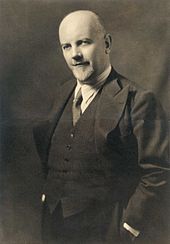Lionello Venturi
Lionello Venturi (born April 25, 1885 in Modena , † August 14, 1961 in Rome ) was an Italian art historian .
Life
Lionello Venturi was the son of the art historian Adolfo Venturi (1856-1941). After his school education at the Liceo classico "Ennio Quirino Visconti" , which he graduated with the Abitur, he studied art history at the University of Rome , where his father taught. In the years 1909-10 he took over the position of deputy director of the Gallerie dell'Accademia in Venice and 1911-1912 of the Galleria Borghese in Rome. In 1912 he became director of the Pinacoteca of the Palazzo Ducale in Urbino . There he studied the Venetian art of the 15th and 16th centuries and the paintings of the school of Michelangelo Caravaggio . From 1914 to 1931 he taught art history at the University of Turin , where he was also appointed professor.
With the outbreak of World War I, he volunteered and lost his right eyesight during combat operations. He received a medal for bravery and was discharged from military service in 1917. In 1919 he resumed his professorship in Turin, which he held for twelve years. During this time the friendship with the lawyer, entrepreneur and patron Riccardo Gualino (1879–1964), with whom he was involved in his Teatro di Torino , began. Venturi instructed Gualino in art-historical matters. Gualino's innovative and successful entrepreneurship turned into eclectic experiments in the artistic field, which were gratefully received by the cultural scene. Venturi had a reputation for being particularly open to new French painters, which Gualino was particularly interested in. After Gualino's departure to Lipari due to disagreements with the new, fascist regime, Venturi went to Paris.
Venturi also belonged to the anti-fascist circle that had come together in Paris under the name Giustizia e Libertà , but which at that time was already infiltrated and well monitored by the state. With the outbreak of World War II, Venturi went to New York and spent the war years lecturing in French at various North American universities. In addition to New York, these were Chicago , Detroit and Philadelphia . In the United States he remained loyal to the anti-fascist resistance movement, which was active there from 1939 under the name Mazzini Society and also admitted to the United Nations as a non-governmental organization . As early as the early 1920s, there had been efforts among the academic Italians in exile around Gaetano Salvemini , Seraino Romualdi and Max Scoli to combat fascist ideas. Romualdi and Scoli later became important figures in the American labor movement.
After the end of the war, Venturi was supposed to be brought back to his old position in Turin, but he wanted to return to his original position as an art historian in Rome, where he started again in 1946.
Publications (selection)
- Cézanne, son art - son oeuvre . Paul Rosenberg, Paris 1936.
- with Ludovic R. Pissarro: Camille Pissarro: son art - son œuvre. 2 volumes, Paris 1939 (New ed. Wofsky, San Francisco 1989, ISBN 1-55660-027-5 ).
- Les archives de l'Impressionisme , Durand-Ruel, New York 1939
- Impressionists and Symbolists . Scribner, New York 1950
literature
- The Dictionary of Art , Grove 1996, Volume 32, ISBN 0-19-517068-7 .
- Giovanni Taurasi (Ed.): Lionello Venturi intellettuale antifascista . Nuovagrafica, Carpi 2006.
- Gianni Carlo Sciolla (Ed.): Giornata di Studi per il Cinquantenario della Morte di Lionello Venturi (1885-1961), 2011, Perugia (= Annali di critica d'arte 10, 2014, Allegato). CB Editore, Poggio a Caiano 2014.
Web links
Individual evidence
- ^ Anne Elizabeth Dymond, Vojtěch Jirat-Wasiutyński: Modern Art and the Idea of the Mediterranean . University of Toronto Press, Toronto 2007, ISBN 9780802091703 , p. 201.
- ↑ Percorsi di critica: un archivio per le riviste d'arte in Italia dell'Ottocento e del Novecento: atti del convegno, Milano, 30 novembre-1 dicembre 2006, Università cattolica del Sacro Cuore Vita e Pensiero 2007, ISBN 9788834314326 , p. 341.
- ^ Biography Riccardo Gualinos ( Memento of February 4, 2015 in the Internet Archive ) on Palazzo Madama , Museo civico d'arte Antica, Turin.
- ↑ Alessandro Martini: L'impegno privato e la passione pubblica, dall'Europa all'Italia. Riccardo Gualino tra teatro, musica e danza, 1923-1931 . In: Stefano Santini, Loreta Mazzoni: Architettura dell'Eclettismo. Il rapporto tra l'architettura e le arti (1930-1960) , vol. 13, Liguori, Naples 2009, ISBN 9788820745905 , pp. 87-120.
- ↑ Antonio Varsori: Gli alleati e l'emigrazione democratica antifascista (1940-1943) . Sansoni, Florence 1982, p. 39.
- ↑ Kaeten Mistry: The United States, Italy and the Origins of the Cold War: Waging Political Warfare 1945-1950 . Cambridge University Press, Cambridge 2014, p. 35.
- ↑ Luciano Caramel: Arte in Italia, 1945-1960 , vol. 31. Vita e Pensiero, 1994, ISBN 9788834348857 , p. 225.
- ↑ See cataloging of Cézanne's works
| personal data | |
|---|---|
| SURNAME | Venturi, Lionello |
| BRIEF DESCRIPTION | Italian art historian |
| DATE OF BIRTH | April 25, 1885 |
| PLACE OF BIRTH | Modena |
| DATE OF DEATH | August 14, 1961 |
| Place of death | Rome |
